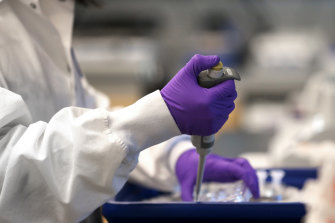Locally produced mRNA vaccine wont be available until at least 2023
Australia is likely to take until 2023 to produce its own messenger RNA vaccines like those from Pfizer and Moderna, as scientists call for a huge federal investment to match countries that already have manufacturing deals.
The federal government is expecting several commercial bids this Friday to build local facilities to produce the mRNA vaccines, but its plans rely heavily on talks with Moderna to lure the US company.

The federal government’s plan to produce mRNA vaccines relies heavily on talks with Moderna to lure the US company.Credit:Getty
Australia is already two months behind other countries in the region in signing a major global partner for local mRNA facilities after Singapore, South Korea and China struck agreements in May for domestic production.
One scientist said the federal government’s funding promises so far were “wildly insufficient†to expand local vaccine research and development to a scale that could attract a company like Moderna.
Melbourne company CSL is seen as the front-runner for a federal deal after its alliance with AstraZeneca to make its “viral vector†COVID-19 vaccine and ramp up production to about one million doses each week.
The government announced a $1.5 billion manufacturing plan last October and has opened talks with Moderna in parallel with its call for proposals from local companies to build new manufacturing centres.
University of Queensland biotechnology professor Trent Munro, who launched a pilot mRNA program in April, said Australia had a “compelling proposition†to produce vaccines for the region because of its reputation for clean and safe manufacturing.
“Australia fundamentally lacks the infrastructure to support our sovereign needs,†he said.
“We should be doing everything we can to attract the companies that can help.
“But unless we do a deal that involves a very strong strategic relationship with a commercial partner that is already doing mRNA, it won’t make much difference.â€
Professor Munro, a former executive at biotech company Amgen in California, said Moderna was relying on contract manufacturers elsewhere in the world and could do the same with an alliance in Australia.
While the time required to build the facilities ranges from six months to three years in estimates put to the government, Industry Minister Christian Porter has cited a middle estimate of 12 to 18 months as more realistic.
“I think it would be exceedingly optimistic, those short timeframes. I think the middle timeframes are the most likely,†he said last week.
The Singapore government announced a deal with Pfizer’s partner BioNTech in May to manufacture “several hundred million†doses of the companies’ mRNA vaccine from early 2023, setting an indicative timeframe for an Australian plan.
BioNTech, which is based in Germany and pioneered the mRNA technology, signed a deal with Chinese company Fosun Pharma in May to build a facility that could produce one billion doses per year.
The South Korean government struck an agreement with Moderna in May to “explore local manufacturing†on mRNA as well as working on vaccine research, alongside a deal for Samsung Biologics to do the “fill-finish†in putting Moderna vaccines into vials for markets outside the United States.
Moderna has expanded its manufacturing in Europe and the US to supply one billion doses this year and three billion next year, while Pfizer and BioNTech are aiming for three billion doses this year and four billion in 2022.
The chief executive of Therapeutic Innovation Australia, Stuart Newman, said the government plan needed to expand local research and development as well as bringing in a global partner.
“Building up sovereign mRNA manufacturing capability is important but we also need to support our researchers to build a vibrant pipeline of potential homegrown therapeutics, otherwise we’ll just be making someone else’s stuff,†he said.
One scientist said it would be a “no-brainer†to expand CSL’s facilities to produce mRNA vaccines at its Seqirus subsidiary in Melbourne, but the company would not comment on whether Australia was at risk of falling behind other countries.
“We’re actively exploring mRNA manufacturing options for the company, and we are interested in being part of the conversation in Australia,†said Seqirus vice president Lorna Meldrum.
“Capacity like this can’t be set up overnight â€" it takes time and investment and CSL’s track record in pandemic preparedness and vaccine manufacturing puts us in good stead to be part of the future in Australia.â€
CSL chief Paul Perreault told The Australian Financial Review this month that it could take five years to build the local mRNA capacity.
“If government can cut through red tape, you might be able to cut a year or two off if you’re really lucky,†he said.
Stay across the most crucial developments related to the pandemic with the Coronavirus Update. Sign up to receive the weekly newsletter.
David Crowe is chief political correspondent for The Sydney Morning Herald and The Age.

0 Response to "Locally produced mRNA vaccine wont be available until at least 2023"
Post a Comment